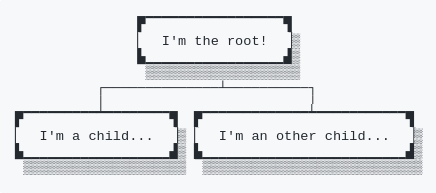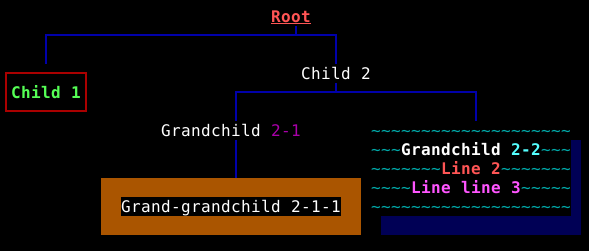Important
Declarative construction of trees is coming.
Please leave a comment on the related issue, if you have an idea about better declaring a tree!
Simple Java library for visualizing tree structures in the command line.
natural foods
├─ fruits
│ ├─ apple
│ ├─ banana
│ ├─ mango
│ ├─ lorem and
│ │ ipsum
│ │ ┌──────────────────────────────────┐
│ │ │ citroideae │
│ ├─│ ┌─────┬─────┴─┬─────────┐ │
│ │ │ orange lemon grapefruit mandarin │
│ │ └──────────────────────────────────┘
│ │ ┌────────────────────────────────┐
│ │ │ berries │
│ │ │ ┌──────┴───────┐ │
│ └─│ grape other │
│ │ ┌──┴─┐ ┌────┴─────┐ │
│ │ red white strawberry raspberry │
│ └────────────────────────────────┘
├─ vegetables
│ ├─ tomato
│ ├─ carrot
│ │ A──────────B
│ └─│ broccoli │
│ D──────────C
└─ seeds
├─ walnut
└─ peanut
Now coloring and other ANSI escapes are supported. See below for more information.
The following breaking changes was made:
TreeNode.content()returns withConsoleText(instead ofString)
The following breaking changes was made:
- Package/class structure was reorganized
- Method naming convention was changed (e. g.
getChildren()→children()) - Most of the telescoping constructors was removed (use builders instead)
- Decorator inheritance was simplified,
forceInheritoption was removed
Furthermore, many little changes, extensions and fixes was added.
This library is open source, and available under the Apache License V2.
The library is compatible with java versions 1.8+.
See the 1.x branch for using the legacy version (compatible with 1.6+).
Built packages are available from the Maven Central Repository.
In gradle projects:
dependencies {
implementation "hu.webarticum:tree-printer:${treePrinterVersion}"
}
In maven projects:
<dependency>
<groupId>hu.webarticum</groupId>
<artifactId>tree-printer</artifactId>
<version>${treePrinterVersion}</version>
</dependency>A tree is a hierarchical structure built from nodes. Any tree is given by its root node.
Nodes implement the TreeNode interface.
It contains default implementations for the majority of its methods,
you must implement only the content() and children() methods.
You can use SimpleTreeNode out-of-the-box as a default string-based implementation:
SimpleTreeNode rootNode = new SimpleTreeNode("I'm the root!");
rootNode.addChild(new SimpleTreeNode("I'm a child..."));
rootNode.addChild(new SimpleTreeNode("I'm an other child..."));However, you are free to implement your custom nodes.
There are multiple built-in implementations of the TreePrinter interface
for printing tree structures via the print() method.
This method accepts a TreeNode (the root node of the printed hierarchy),
and, optionally, an Appendable object, to where the output will be flushed
(by default, output will be printed to System.out).
Alternatively, you can get the visualization as String via stringify().
In some cases this is inefficient (especially when you print large data with ListingTreePrinter).
It is very easy to visualize the above structure:
new ListingTreePrinter().print(rootNode);And the result:
I'm the root!
├─I'm a child...
└─I'm an other child...
Or use a TraditionalTreePrinter:
new TraditionalTreePrinter().print(rootNode);Which results:
I'm the root!
┌─────────┴───────┐
│ │
I'm a child... I'm an other child...
For more available printers see the hu.webarticum.treeprinter.printer.* packages.
Of course, TreePrinter implementations have many options for controlling the output.
You can change the lining characters, the aligning, and so on.
Most classes have builders and some basic constructors for easy change of settings. For example, if we want to align everything to left:
new TraditionalTreePrinter(
DefaultAligner.builder()
.align(DefaultAligner.Alignment.LEFT)
.build(),
TraditionalTreePrinter.DEFAULT_LINER
).print(rootNode);Result:
I'm the root!
├──────────────┐
│ │
I'm a child... I'm an other child...
You can easily write node decorators by extending AbstractTreeNodeDecorator.
There are built-in implementations for adding
padding, border, shadow and other basic decorations.
In the previous example the child nodes are confused, because only a single space separates them. It will be much cleaner if we added a border:
new TraditionalTreePrinter().print(new BorderTreeNodeDecorator(rootNode));Result:
┌─────────────┐
│I'm the root!│
└─────────────┘
┌──────────┴────────┐
│ │
┌──────────────┐ ┌─────────────────────┐
│I'm a child...│ │I'm an other child...│
└──────────────┘ └─────────────────────┘
Of course, you can compose as many decorators as you want:
TreeNode decoratedTreeNode = new ShadowTreeNodeDecorator(
BorderTreeNodeDecorator.builder()
.wideUnicode()
.buildFor(
new PadTreeNodeDecorator(rootNode, new Insets(0, 2))));
new TraditionalTreePrinter().print(decoratedTreeNode);Result:
Decorators inherit by default, but you can change this behavior.
You can put placeholder nodes into the tree. These nodes are hidden by default in the general printers. Placeholders are useful in n-ary trees, where missing nodes matter.
boolean displayPlaceholders = true;
SimpleTreeNode alignedTree = new SimpleTreeNode("ROOT");
alignedTree.addChild(new PlaceholderNode());
alignedTree.addChild(new SimpleTreeNode("RIGHT"));
new TraditionalTreePrinter(displayPlaceholders).print(
PadTreeNodeDecorator.builder()
.horizontalPad(3)
.buildFor(new BorderTreeNodeDecorator(alignedTree))); ┌────┐
│ROOT│
└────┘
┌──────┴──┐
│ │
┌─────┐
│RIGHT│
└─────┘
Any node whose isPlaceholder() method returns true is considered a placeholder.
hu.webarticum.treeprinter.PlaceholderNode is a built-in placeholder,
it's empty and undecorable too.
Built-in objects that print lines or borders have a built-in set of characters, both for ASCII and Unicode mode.
Affected classes have a constructor/builder parameter useUnicode.
You can globally change the default mode with UnicodeMode.setUnicodeAsDefault().
(Initial global default is Unicode.)
The first example with ASCII rendering:
ListingTreePrinter.builder().ascii().build().print(rootNode);Result:
I'm the root!
|-I'm a child...
'-I'm an other child...
Coloring and other ANSI escapes are supported with the following features:
- ANSI formatting support was added to built-in decorators and printers (e. g. colored lining)
ConsoleTextand its implementations was added for better handling of textsAnsiFormatand its basic constant instances was added, it's composable- global
AnsiModeadded (similar toUnicodeMode), ANSI can be disabled globally - width of custom ANSI formatted texts is handled properly
Interface ConsoleText represents textual content intended for display in the command line.
ConsoleText.of(String) (or new PlainConsoleText(String)) represents some plain text (without formatting).
ConsoleText.ofAnsi(String) (or new AnsiConsoleText(String)) holds text possibly with format escapes.
Both normalizes newlines and unicode codepoints.
Both clears non-printable characters, expect that the latter keeps ANSI format escapes.
It's not necessary to write ANSI escapes by hand.
The AnsiFormat class represents a formatting, and can be applied to any ConsoleText.
Also, it's composable.
Let's see a simple example:
ConsoleText.of("Hello ANSI").format(AnsiFormat.GREEN);This will make the text "Hello ANSI", in green.
Here is a little bit more complex use case:
ConsoleText.of("Hello ").concat(ConsoleText.of("ANSI").format(AnsiFormat.GREEN)).format(AnsiFormat.BOLD);Now only the word "ANSI" is green, but the whole text is in bold.
We can create a colorful tree:
SimpleTreeNode rootNode = new SimpleTreeNode(ConsoleText.of("Root").format(
AnsiFormat.UNDERLINE.compose(AnsiFormat.BOLD).compose(AnsiFormat.RED)));
SimpleTreeNode childNode1 = new SimpleTreeNode(
ConsoleText.of("Child 1").format(AnsiFormat.GREEN.compose(AnsiFormat.BOLD)));
rootNode.addChild(new BorderTreeNodeDecorator(childNode1, AnsiFormat.RED));
SimpleTreeNode childNode2 = new SimpleTreeNode("Child 2");
rootNode.addChild(childNode2);
SimpleTreeNode grandChildNode22 = new SimpleTreeNode(
ConsoleText.of("Grandchild ")
.concat(ConsoleText.of("2-2").format(AnsiFormat.CYAN)).breakLine()
.concat(ConsoleText.of("Line 2").format(AnsiFormat.RED)).breakLine()
.concat(ConsoleText.of("Line line 3").format(AnsiFormat.MAGENTA))
.format(AnsiFormat.BOLD));
childNode2.addChild(new ShadowTreeNodeDecorator(
JustifyTreeNodeDecorator.builder()
.minimumHeight(5).minimumWidth(20)
.verticalAlign(VerticalAlign.MIDDLE).horizontalAlign(HorizontalAlign.CENTER)
.background('~').backgroundFormat(AnsiFormat.CYAN)
.buildFor(grandChildNode22), AnsiFormat.BLUE));The built-in printers and decorators are formattable too. Let's print the above nodes connected with some blue lines:
new TraditionalTreePrinter(AnsiFormat.BLUE).print(rootNode);Depending on the terminal, the result will be something like this:
For more examples see the AnsiExamplesMain demo.
Study the API to find more possibilities.
There are various ideas in the backlog that are planned to be implemented in the next versions, such as:
- More
TreePrinterimplementations - More flexible alignment settings
- Improved
TraditionalTreePrinter - and more

